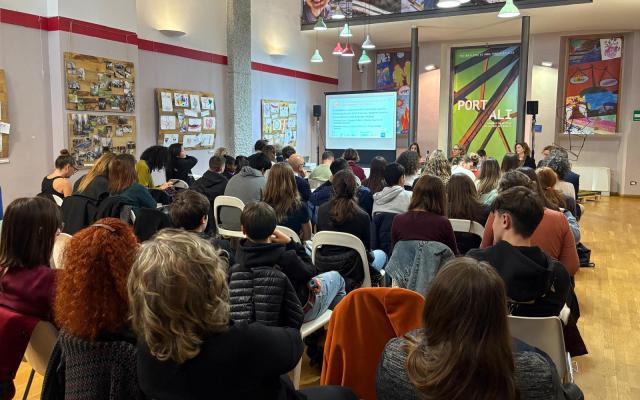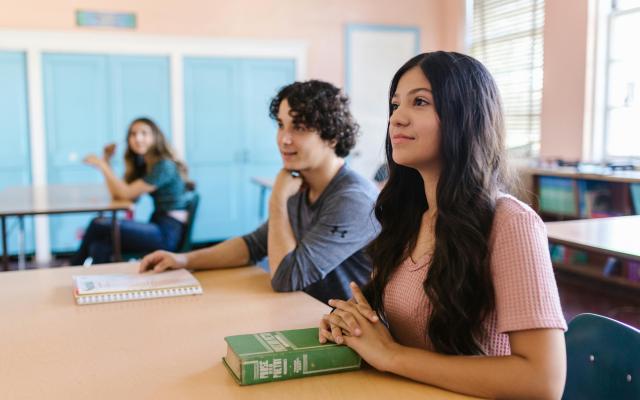The experience of the Dalla Chiesa comprehensive institute in Rome
In the Digital Citizenship and Creativity workshop, set up at the primary school of the Carlo Alberto Dalla Chiesa comprehensive institute in Rome, the fight against cyberbullying has been transformed into a collective exercise in imagination and awareness. The activity is part of the courses funded by the National Recovery and Resilience Plan (‘New skills and new languages’, decree 65/2023) which are ongoing until 10 April and also involve nursery and lower secondary schools.
Primary school children already completed their programme on 13 March, working on the creation of a story in images of episodes of cyberbullying that they themselves had devised. Each story was conceived, represented and photographed as a group, with surprising results in terms of empathy and emotional intelligence. One title in particular, coined by the children, encapsulates the spirit of the project: S.T.O.P., which stands for ‘Stay away | Trust an adult with whom you can talk | Online sites are great, but don't waste time on others | Please think before you post’.
Our trainer Giorgia Spigarelli tells us about her experience in an interview with Onelia Onorati. Originally from the area around Lake Como but living in Rome for many years, Giorgia has a degree in sociology and has combined this with other interests and activities: she is a professional photographer, has a master's degree in refugee reception and is also a cultural mediator. ‘For twenty years I have been trying to merge these different aspects of my training and I have succeeded through working with schools, where I run workshops on inclusion, safety and respect online’.
With third, fourth and fifth graders it was easy to embark on a journey on the topic of cyberbullying: ‘they all know what a digital offence is and were able to express mental associations thanks to the photographic medium. After the initial discussion, the children devised several stories related to online violence. The teachers participated, collaborated and supported the stories and the creation of the photographs. In a subsequent phase, after learning some basic photographic techniques, the children, divided into groups, created photo stories, all very different from each other,’ says Giorgia.
Why choose to use images? ‘Photography is a form of writing that uses light but is very immediate, it also captures details and nuances well. An interesting element was that of training, the children felt important because they handled sophisticated tools such as professional reflex cameras, they were able to try out a technology and develop a skill’.
The stories they told were very realistic and varied: ‘some talked about new pupils who change schools and find a hostile environment, others imagined a deaf child being mocked on social media. The children also invented a story centred on a teacher who is the victim of cyberbullying, and this shows a very strong sensitivity. These ideas are the result of stories heard from adults or older siblings, reworked and enriched by harmonious group work. The titles chosen are very catchy, such as ‘Danger runs online’ or ‘Bullying becomes bellism’, ‘A network of teasing’. All the endings of the stories are positive, the problems presented are always solved, and adults are often brought into the story. Each story was staged without showing the children's faces, using masks’.
The idea that can be drawn from these works is that primary school children are familiar with electronic devices. ‘They are projected into the virtual world, they often have devices all to themselves, but they know that what happens online is real. Many of them know the story of The Boy in the Pink Trousers, but it's important to be much more thorough in informing them of the risks they run online’.
The picture for parents is perhaps less bleak than in the past: ’While some adults leave their children at the mercy of the internet without any control, most seem careful to limit internet access, setting a maximum connection time. But there is a lack of control over online gaming platforms. Parents are often not really aware that through video games children can be approached by people outside their circle of acquaintances, nor that they are subject to real offences’, concludes Giorgia.
The activity is part of the Fondazione Mondo Digitale's integrated educational policy for the digital well-being of young people, schools and families. As indicated in the document Policies against bullying and cyberbullying, the Foundation promotes a participatory and multidimensional approach, which focuses on affective education, digital citizenship and the involvement of the educational community. The objective is to transform schools into safe and inclusive environments, where learning technology goes hand in hand with the construction of healthy and responsible relationships.
In children's drawings there are many female heroines, endowed with nice superpowers.




